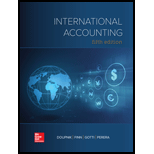
International Accounting
5th Edition
ISBN: 9781260466492
Author: Doupnik, Timothy
Publisher: MCGRAW-HILL HIGHER EDUCATION
expand_more
expand_more
format_list_bulleted
Question
Chapter 5, Problem 30EP
To determine
State the revenue recorded by Company L for the customer’s purchases using card during December and compute the value of unearned revenue liability connected to the card as of Dcember31, Year 1.
Expert Solution & Answer
Want to see the full answer?
Check out a sample textbook solution
Students have asked these similar questions
How much was the equity of Aurum Resources Ltd worth ??
Raytheon Ltd. bought furniture for $10,000 and paid an additional $500 for delivery and $300 for installation. The company also spent $200 on repairs after purchase. Calculate the capitalized cost of the furniture.
Banksy Corp uses predetermined overhead rates based on labor hours. The monthly budgeted overhead is $360,000 and the budgeted labor hours were 60,000. During the month the company worked a total of 50,000 labor hours and actual overheads totaled $280,000. The overhead at the end of the month would therefore be $___?
Chapter 5 Solutions
International Accounting
Ch. 5 - Prob. 1QCh. 5 - Prob. 2QCh. 5 - 3. What is a constructive obligation?
Ch. 5 - Prob. 4QCh. 5 - Prob. 5QCh. 5 - Prob. 6QCh. 5 - Prob. 7QCh. 5 - Prob. 8QCh. 5 - Prob. 9QCh. 5 - Prob. 10Q
Ch. 5 - 11. What are the rules related to the recognition...Ch. 5 - Prob. 12QCh. 5 - Prob. 13QCh. 5 - What are the five steps that entities take to...Ch. 5 - Prob. 15QCh. 5 - Prob. 16QCh. 5 - Prob. 17QCh. 5 - What is breakage revenue?Ch. 5 - What are the three categories of financial assets...Ch. 5 - Prob. 20QCh. 5 - Prob. 21QCh. 5 - What is the primary difference between how IFRS...Ch. 5 - Prob. 23QCh. 5 - Prob. 24QCh. 5 - Prob. 25QCh. 5 - Prob. 26QCh. 5 - Prob. 27QCh. 5 - A cement manufacturer has cement plants around the...Ch. 5 - Prob. 29QCh. 5 - How much revenue must be generated by a companys...Ch. 5 - How is a major customer defined?Ch. 5 - 1. Halifax Corporation has a December 31 fiscal...Ch. 5 - 2. Bull Arm Company has the following items at...Ch. 5 - 3. Melbourne Inc. became involved in a tax dispute...Ch. 5 - Prob. 4EPCh. 5 - Prob. 5EPCh. 5 - Prob. 6EPCh. 5 - Prob. 7EPCh. 5 - 8. Sandoval Company operates in a country in which...Ch. 5 - Which of the following is a criterion that must be...Ch. 5 - Prob. 10EPCh. 5 - Siam Financial Corp. (SFC) actively trades bonds...Ch. 5 - A 3 million loan paying annual interest at a 5...Ch. 5 - Monterrey Properties enters into a 3-year lease...Ch. 5 - 10. An entity must adjust its financial statements...Ch. 5 - Prob. 15EPCh. 5 - Prob. 16EPCh. 5 - Prob. 17EPCh. 5 - Prob. 18EPCh. 5 - Prob. 19EPCh. 5 - Prob. 20EPCh. 5 - Prob. 21EPCh. 5 - Prob. 22EPCh. 5 - Prob. 23EPCh. 5 - Prob. 24EPCh. 5 - Prob. 25EPCh. 5 - Prob. 26EPCh. 5 - Prob. 27EPCh. 5 - Prob. 28EPCh. 5 - Prob. 29EPCh. 5 - Prob. 30EPCh. 5 - Prob. 33EPCh. 5 - Prob. 34EPCh. 5 - Prob. 35EPCh. 5 - Prob. 36EPCh. 5 - Prob. 37EPCh. 5 - Prob. 38EPCh. 5 - On January 1, Year 1, Autonomous Systems Ltd....Ch. 5 - Prob. 40EPCh. 5 - Prob. 41EPCh. 5 - Prob. 42EP
Knowledge Booster
Learn more about
Need a deep-dive on the concept behind this application? Look no further. Learn more about this topic, accounting and related others by exploring similar questions and additional content below.Similar questions
- what is the materials quantity variance?arrow_forwardOn January 1, 2012, Penn Manufacturing purchased equipment for $865,000, having a useful life of 8 years and an estimated salvage value of $62,000. Penn has recorded monthly depreciation of the equipment using the straight-line method. On December 31, 2018, the equipment was sold for $295,000. As a result of this sale, Penn should recognize a gain of ___.arrow_forwardoperating laverage is 3.5?arrow_forward
- What is depreciation, and why do companies apply it to fixed assets? Discuss at least two methods of calculating depreciation and how they affect a company’s financial reporting over time. Need answerarrow_forwardWhich account is not closed at the end of an accounting period? Consider typical accounts maintained in the general ledger. (A) Sales (B) Wages Expense (C) Capital (D) Rent Revenue HELParrow_forwardCurrect answerarrow_forward
arrow_back_ios
SEE MORE QUESTIONS
arrow_forward_ios
Recommended textbooks for you
- Principles of Accounting Volume 1AccountingISBN:9781947172685Author:OpenStaxPublisher:OpenStax College

Principles of Accounting Volume 1
Accounting
ISBN:9781947172685
Author:OpenStax
Publisher:OpenStax College
7.2 Ch 7: Notes Payable and Interest, Revenue recognition explained; Author: Accounting Prof - making it easy, The finance storyteller;https://www.youtube.com/watch?v=wMC3wCdPnRg;License: Standard YouTube License, CC-BY